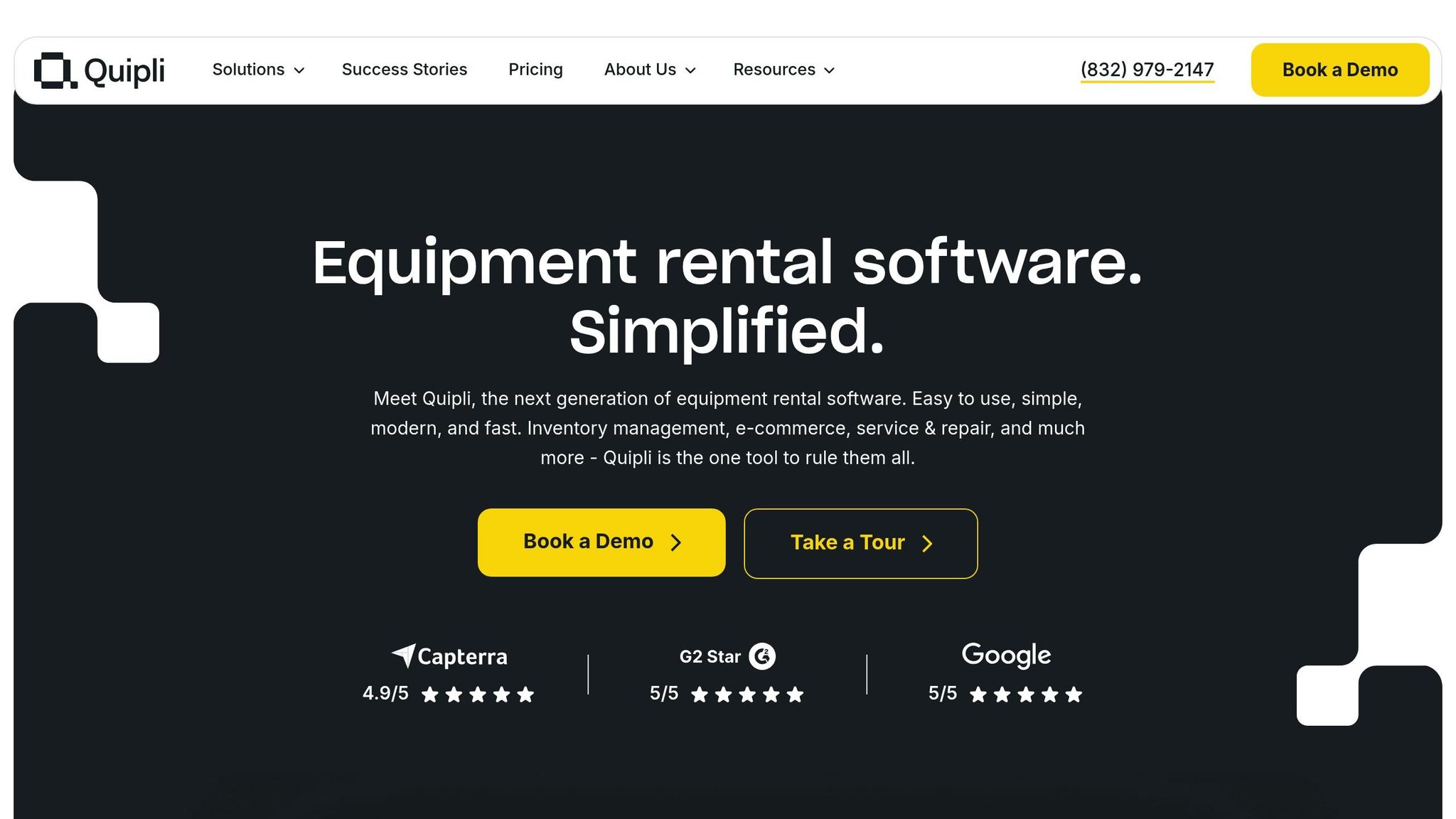
Computer rental software is transforming how rental businesses operate, helping save time, cut costs, and improve customer service. Here’s what you need to know:
- Key Features: Real-time inventory tracking, automated billing, maintenance scheduling, and mobile access.
- Emerging Trends: AI for predictive maintenance, cloud-based solutions for accessibility, and 24/7 automated rental systems.
- Best Practices: Use dynamic pricing to maximize revenue, self-service tools for customer convenience, and preventive maintenance to reduce downtime.
- Implementation Tips: Match software to business goals, train staff effectively, and prioritize data security.
Quipli Equipment Rental Software Demo (Updated October …

Current Computer Rental Software Trends
The computer rental industry is undergoing changes driven by advancements in technology. These developments are reshaping how businesses operate and interact with their customers.
AI and Machine Learning Applications
AI is making rental operations smarter and more efficient by automating tasks and providing predictive insights.
"I believe that, at some level, we will see AI adopted in every single business as a simple aid to daily tasks, as we’ve seen the world adopt ChatGPT as a ubiquitous work companion seemingly overnight".
Here’s how AI is making an impact:
- Predictive maintenance: AI systems can detect potential equipment issues before they lead to downtime.
- Inventory management: By analyzing usage data, AI helps maintain optimal stock levels.
- Customer service: AI-powered chatbots offer instant support, anytime.
Cloud and Mobile Solutions
Cloud and mobile technologies give operators the ability to access and manage data in real time, from anywhere.
Some key advantages include:
- Instant data access: Teams can update and retrieve rental information on any device.
- Compatibility: Software works smoothly across different operating systems.
- Automated updates: New features roll out without interrupting daily activities.
- Integration options: Cloud tools connect seamlessly with other business systems.
24/7 Automated Rental Systems
IoT and smart devices are enabling fully automated rental operations that function around the clock. These systems include:
- Digital contracts with automated signatures
- Smart locks for secure, remote access
- Automated payment systems
- Remote monitoring for added control
"We believe that harnessing these new AI technologies will help improve our customers’ experience, make rental faster and more efficient, and ultimately help our customers outperform their competition".
One standout example is John Deere’s SmartDetect™ technology. Using computer vision and machine learning, it identifies people near construction equipment and alerts operators, enhancing workplace safety.
Ways to Improve Rental Operations
Improving rental operations involves making smarter decisions based on data, managing inventory efficiently, and creating a better experience for customers. These steps can help fine-tune pricing, keep inventory under control, and give customers more control over their rentals.
Smart Pricing and Data Analysis
Using dynamic pricing can help maximize revenue. By adjusting rates based on market trends, you can stay competitive and boost profits. Studies show that algorithmic pricing can increase the Average Daily Rate by 5% to 15% and improve occupancy by 2% to 3% compared to fixed pricing models.
"Dynamic pricing refers to the practice of adjusting prices based on demand, competition, and other external factors."
Here’s how you can make it work:
- Keep an eye on market demand changes
- Regularly review competitor pricing
- Study past rental trends
- Set clear pricing rules with sensible limits
Stock and Maintenance Control
Keeping equipment in good condition and minimizing downtime is essential for smooth operations. Preventive maintenance can save 12% to 18% compared to fixing issues as they arise.
Key strategies include:
- Use GPS or RFID tracking to monitor equipment and automate maintenance schedules based on usage
- Implement digital inventory systems with barcodes to simplify check-in and check-out processes
Customer Self-Service Options
Self-service tools make it easier for customers to manage their rentals while cutting down on operational costs. Features like online booking, digital contracts with e-signatures, SMS updates, and secure customer portals can save time and improve the customer experience.
To get the best results, integrate self-service tools with your existing systems. Make sure to prioritize security by verifying customer identities and using encrypted payment methods to protect sensitive data.
sbb-itb-c79a83b
Software Implementation Steps
Implementing software effectively ensures it meets business needs, equips staff with necessary skills, and protects sensitive information.
Matching Software to Business Goals
Begin by addressing key operational challenges. Andy Clark, sales director, Americas, at Point of Rental Software, highlights:
"Rental companies choose to move or upgrade their rental management systems based on their current system’s (or lack thereof) ability to help solve their most immediate problems or business objectives."
Key steps to align software with business goals:
-
Audit Current Operations
Review essential tasks and identify manual processes that hinder efficiency. -
Involve Key Stakeholders
Engage skeptics early to encourage team buy-in. Joe Lewis, president of Fame Intel, emphasizes:"Strong management leadership is No. 1. The second trick is to involve the skeptics at the beginning… allow them to be part of the assessment of the product and have them lead their teams from start to finish, everybody else comes along."
-
Calculate ROI
Evaluate the costs of sticking with the current system to justify the investment in new software.
Staff Training Methods
Proper training ensures a smooth transition. Research indicates that businesses with engaged employees achieve 21% higher profitability and 17% greater productivity.
| Training Phase | Duration | Key Components |
|---|---|---|
| Initial Onboarding | 2–3 days | POS basics, navigation, and core features |
| Advanced Training | 4–6 days | Customer service, inventory management, reporting |
| Ongoing Support | Continuous | Updates, refresher sessions, and new feature overviews |
"Share with each person or team how will they benefit (from the software) in their role… Have key staff in every training session and don’t mistake ‘no objections or no questions’ as a positive."
Keep sessions short – 15 to 60 minutes – for better focus and retention. Include role-playing and hands-on activities to reinforce learning.
Data Security Requirements
Prioritize security with these measures:
- Access Control: Use role-based permissions.
- Payment Security: Encrypt payment processing.
- Data Backup: Automate regular backups.
- Compliance: Follow industry regulations and standards.
- Security Updates: Apply patches promptly.
Train employees on data handling procedures and perform regular security audits. As noted:
"Rental companies should look for a software partner that provides extensive knowledge bases, ongoing supplemental training and consultative services to help their employees best leverage the software."
These practices form a strong foundation for evaluating the software’s impact in the next section on success measurements.
Success Measurements
After implementing new software, it’s crucial to assess its impact using specific metrics. Focus on key performance indicators (KPIs) that measure efficiency and support business growth. These metrics help quantify improvements and guide future adjustments.
Income and Usage Stats
Keep an eye on utilization rate – how often computers are rented out. For a thriving rental business, annual rental sales should grow by at least 10%. Some important metrics to track include:
- Equipment turnover: How frequently rentals occur
- Revenue per unit: Earnings generated per rental
- Downtime rate: Percentage of time equipment is unavailable
- Maintenance costs: Expenses for keeping devices in working order
Customer Reviews and Ratings
Usage stats only tell part of the story. Customer feedback fills in the gaps by highlighting satisfaction levels, which are critical for repeat business and referrals. Use these methods to gather insights:
- Post-rental surveys: Collect immediate feedback from customers
- Net Promoter Score (NPS): Gauge how likely customers are to recommend your service
- Service quality metrics: Measure response times and issue resolution efficiency
"Effective equipment rental KPI (Key Performance Indicators) are essential for evaluating the success and efficiency of event equipment rental businesses. These metrics provide valuable insights into various aspects of operations, from utilization rates to customer satisfaction. By monitoring and analyzing equipment rental KPIs, businesses in the equipment rental sector can make informed decisions that enhance performance, streamline processes, and ultimately drive profitability." – rentman.io
Business Performance Metrics
To get a full picture of your business health, look beyond immediate income and usage stats. Broader metrics reveal how well your operations are running.
- Operational Efficiency: Track on-time delivery rates, equipment prep times, and maintenance response times. Use tools like GPS or RFID for real-time tracking.
- Financial Performance: Monitor revenue per unit and maintenance costs to evaluate profitability. With the US equipment rental market projected to reach $52.7 billion in sales, financial tracking is critical.
- Process Automation: Compare automated tasks to manual ones. Measure digital contract completion rates and payment processing speed. Set clear automation goals and review progress regularly.
Regularly reviewing these KPIs helps identify trends, pinpoint inefficiencies, and find new ways to improve rental operations.
Conclusion
The computer rental industry is projected to hit $82.6 billion by 2025, and technology plays a key role in shaping its future. AI and machine learning are transforming rental operations with features like smart inventory management and predictive analytics.
"AI and ML are becoming integral to rental system software, enabling predictive analytics for demand forecasting, pricing optimization, and personalized customer service".
Cloud-based systems further improve operations by offering real-time inventory tracking, automated workflows, data-driven pricing, and better mobile connectivity. These tools are driving the efficiencies highlighted earlier.
In North America alone, the rental inventory management sector is expected to see 7.9% revenue growth in 2024, showcasing how technology is fueling industry expansion. To keep up, rental companies should focus on tracking systems, analytics, online booking, self-service options, and CRM integration to strengthen customer relationships.